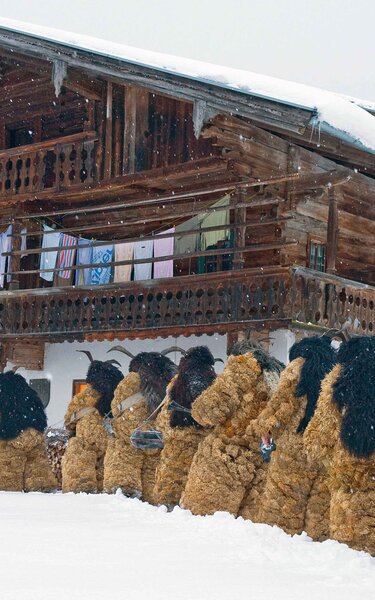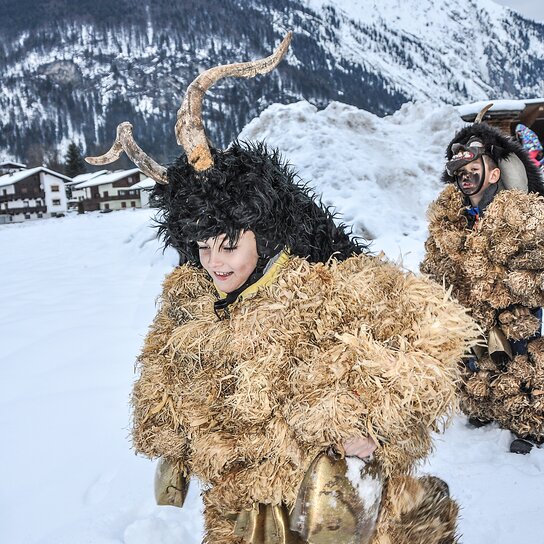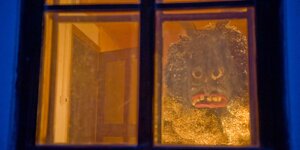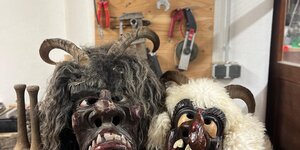
Perchten & Krampus


Devil, Krampus and Perchten
When the pre-Christmas period begins, old traditions come to life in the Alpbachtal. Every year around 5th December, eerie figures parade through Tyrol: this is the time of the Krampus - a horned, anthropomorphic figure - and Perchten (the word Perchten (plural of Perchta) refers to the female masks representing the entourage of an ancient goddess, Frau Perchta) - an alpine form of the devil. The most rustic forms of these can still be seen today in the Alpbachtal holiday region, with Breitenbach am Inn being a particular hotspot.
All you need to know
In Tyrol, Krampus is known by various names, including devil, Kramperl and Perchten. However, there are subtle differences between these designations. Some of the traditions and customs vary from place to place. In general, however, it can be said that the Krampus and the Percht appear pre-Christmas. The official Krampus day is the 5th of December, but many events in Tyrol also take place starting mid-November. Despite their terrifying appearance, Krampus and Perchten are seen as protectors against evil in many areas. A disguised group that takes part in a so-called "Krampuslauf" or "Perchtenlauf" is known as a "Pass".
The Krampus is traditionally regarded as St. Nicholas' sinister companion. In contrast to St. Nicholas, from whom the children receive presents. Krampus comes to the children who have not been good during the year with his wicker rod and chains instilling fear. In some regions Krampus is also called devil.
In contrast to Krampus, the Perchten disguise themselves with costumes made of corn husks instead of fur. According to ancient tradition, the Perchten are supposed to drive away the evil winter spirits with their bells, making them auspicious protectors.

Perchten tradition in Breitenbach
Everywhere in the villages, the old customs surrounding the dark figures are still lived and cultivated. But not all customs are the same. While in some places the "Perchten groups" have adapted to the times, in other places the traditional knowledge and traditions are still strictly adhered to.
In the Tyrolean lowlands, in Breitenbach and the neighbouring villages of Angerberg and Mariastein, lies the origin of the eerie custom. At least that's what the people of Breitenbach claim. In the local dialect, people speak of the "Peaschtln", who are out and about every year around 5th December. A group is referred to as a "Pass".
Plastic masks and fire performances are frowned upon in Breitenbach. Instead, the people of Breitenbach wear original wooden masks and robes made with corn husks. The most obvious feature is their ornate wooden masks, which local carving legends created with great patience and experience. Some of these can cost several hundred to a thousand euros.
According to age-old custom, the Breitenbach "Peaschtel Pass" (how they are called in the regional dialect) parade from farm to farm with up to 30 men, led by the witch.






There are strict rules: All houses are entered in the traditional order.
In Breitenbach am Inn, each pass is preceded by a witch. They are followed by the drummers with large drums made from old tanks and wooden drummers' smocks. They are followed by the blowers with bugles or signal horns and finally the Hüpfer who hop and jump with huge bells. Loud "music is made" when they arrive at the farm. The drums are beaten and blown vigorously and the Hüpfer jump as high as they can. This brings the visitors luck and a rich harvest.
"The higher the Peaschtln hop, the higher the grain, maize, fruit and crops will grow." In addition to a good harvest, the Peaschtln also hop as high as possible for good luck and health on the farm. The witch sweeps on her way out, which is how the magical custom unfolds.
The newly arrived pass plays music in front of the house until the witch of another pass comes outside. It can happen that a good 20 passes visit a house in one day.
The "Peaschtl-Costume"
We were allowed to take part in the production of a “Peaschtl-Costume” and visited Florian Hausberger in Breitenbach, who gave us a look behind the scenes.
The Peaschtl costumes are handmade from corn flakes. Production begins with removing the corn cobs from the plant. The husks are then removed from the corn cob, dried for weeks and then further processed on the Hache-Brettl. The resulting small tufts are then sewn onto the garments.
It's hard to believe, but each garment is the result of at least 50 hours of manual work!














